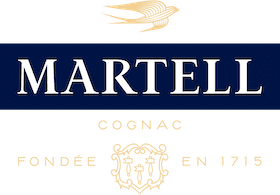The surprising story of cognac grapes

Ugni Blanc explained
Ever wondered where cognac comes from? The short answer is grapes, and one in particular.
As with wine, each cognac bears its own distinct character and personality. So it may be surprising to learn that a single cognac grape variety, Ugni Blanc, accounts for more than 98% of the Cognac region’s vineyards.
The reason the main grape used in cognac is Ugni Blanc owes as much to a fault of history, as to the grape’s own characteristics.
First things first, let us return to some fundamentals. Only grapes listed in the strict Cognac Protected Designation of Origin (PDO) specifications can be used to produce the famous amber spirit.
These grapes are grown in six crus spread over approximately 75,000 hectares, mainly in the Charente and Charente-Maritime areas, in southwest France.
Martell only sources its fruit from the four finest crus, of which Borderies is the smallest, representing only 5% of cognac vineyards. Then there is Grande Champagne, famed for its chalk and limestone soils, the Petite Champagne cru which surrounds it, and finally Fin Bois, known for the freshness and lightness of eaux-de-vie it produces.
Of Tuscan origins, Ugni Blanc has a high yield and late maturation, producing wines that are low in alcohol yet high in acidity. These traits are important because the acidity preserves the wines naturally prior to their distillation, while the low alcohol levels allow for a greater concentration of aromas. Distillation of Ugni Blanc produces delicate and floral wine spirits.
Resistant to disease
Yet perhaps the most important characteristic of Ugni Blanc is that the variety is relatively resistant to disease.
The arrival of phylloxera in the 19th century wiped out most of the vineyards in the Charente, with the result that most of today’s vines have been in fact grafted on a variety of rootstocks. Among its many economic, social and other consequences, the disease would change the taste of cognac forever.
In earlier times the dominant grape variety used to make cognac was Folle Blanche, a white grape that produces low-alcohol wines, and well-balanced wine spirits. Yet this variety was decimated by phylloxera, and today accounts for less than 1% of vines planted in the region.
Among the other grapes used in cognac today, one finds Colombard. High in acidity and low in sugar, it is one of the region’s oldest varieties that exists still today.
There is also the Montils variety. It ripens earlier and has lower acidity than , and is known for the high-quality spirits it produces, albeit in limited quantity.
Finally, Folignan is a new variety only officially added to the PDO guidelines in 2005.
Created as a hybrid between Ugni Blanc and Folle Blanche, the variety bears testament to the importance of evolution for survival, whether in grapes – or the cognac industry itself.
Please do not share with anyone under 18. Drink responsibly.










